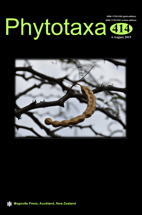Abstract
Tashiroea dayaoshanensis (Melastomataceae, Sonerileae), a species from northeastern Guangxi, China and previously often identified as Phyllagathis nudipes or P. oligotricha in Chinese herbaria, is described as new based on morphological and molecular data. Indumentum, leaf texture and surface sculpture, capsule morphology and molecular phylogenetic data strongly support the placement of T. dayaoshanensis within the Tashiroea clade which should be accommodated in Tashiroea. Morphology as well as sequence divergence of the nrITS region indicate that T. dayaoshanensis is well differentiated from other species in the same clade, and thus should be treated as a distinct species. Tashiroea dayaoshanensis is phylogenetically closest to Bredia sessilifolia but can be easily distinguished by its petiolate leaves (vs. sessile or subsessile), and crowned ovary (vs. uncrowned). It resembles P. nudipes and P. oligotricha in habit and stamen morphology but differs from both in its leaf apex acuminate (vs. acute to obtuse), connective ventrally tuberculate (vs. not tuberculate) and ovary crown exerted from calyx tube during young fruit stage (vs. not exerted).

